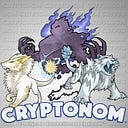Hey Guys/Gals!
It’s that time! We’ve officially wrapped up this alpha phase of development for our PoC, Cryptonom! Let’s take a look at what we’ve got going on and recap exactly what we did! Here we go!
What problem does your project solve for and what was the user need for creating your token economy?
We started this project months before Alpha III had been announced with a unique vision: How could we make something that is familiar (as to not completely alienate the audience), but also unique (different/not a copycat) AND do something that Users really care about when it comes to actual rewards (backed by OST instead of imaginary points, etc)? How could we create a vibrant ecosystem that can be self-sustained and keep users coming back using several progression systems?
What we wanted to demonstrate were the (very) early workings of the above questions getting answered, using OST KIT. Again, we understand this is the very early goings but there is a process in place that we feel will evolve and progress as features/functions are layered in.
We want to replace the often ‘bolted-on’ reward systems of mobile games (all ‘in-game’/non-tangible ‘real’ currency) with something that Users can truly benefit from and something they can earn real money with if they so choose.
The NOM token is key to the Cryptonom ecosystem. Users will use the BT (branded token/NOM token) to evolve their creatures, buy packs of NOMs, buy a NOM through the Exchange (the marketplace for Cryptonom), trade a NOM (NOM tokens will be used to cover a fee/per user-to-user transactions), among other actions. Caching a unique NOM, for 24 hour periods, will earn the User NOM tokens which will serve as a main focus for the community once launched.
OST and it’s versatility simply checked off a lot of the boxes we needed in order to get the project rolling.
What was your key goal behind doing the challenge?
Our key goal was to integrate all of the necessary features required for the competition and to give a working example (albeit, very early example) of how our token economy and general/basic functions will work. From this starting point we can then start to layer on all other features since the foundation is now complete.
How did you plan the design for your wallet features?
With the new Wallet Lite version of the OST API, we were able to more efficiently gather the data for users. With the ‘My Account’ page, we needed to show all the required data to the User, and the new API endpoints allowed us to do this effortlessly.
The ledger gave us access to the User’s recent transactions, allowing us to intelligently display this information to the user. We also display the User’s balance, dynamically, pulling directly from the blockchain via the API. Lastly, when purchasing tokens, the Token Details endpoint allowed us to accurately display the price in USD to the user for the amount of tokens selected with much ease.
Designing the UI, was a mix of WIX (platform) and JavaScript (coding). Javascript allowed us to directly pull data from the blockchain via the API, and WIX allowed for a simple way to integrate that data.
What did you like about using these APIs?
These new API endpoints made retrieving user information more streamlined and efficient. In order to pull a User’s balance, we previously needed to retrieve the entire user object and parse through to pull out the balance. With the wallet and ledger API, we can request just the data we need, saving lines of code, increasing efficiency and decreasing bandwidth.
What did you learn about designing these wallet features?
In designing the new wallet features, we’ve learned that while some things are possible with the right amount of understanding and willingness to code, that doesn’t make it the best way to accomplish a goal; back-end services matter. Keep it simple, user-focused and the rest falls into place.
A few more things before we let you go:
Here’s a visual example (below) of how a User would navigate their account and purchase some NOM tokens!
Check out the link below for our final Cryptonom PoC walkthrough video with Adam W!
https://www.youtube.com/watch?v=pdBa2AHaWJY
There you have it! That’s the Cryptonom PoC and this is just the beginning! We plan on continuing with our weekly blog posts to keep everyone up to date with all the progress being made!
We’d like to thank OST for giving us the opportunity to showcase an idea and to bring that idea to life! We’d also like to thank our family, friends and anyone else that gave us your time/attention in an effort to help with this project!
See ya next week!
Will M.
[The Cryptonom squad consists of: Will M, Adam W and Bill M. Special recognition to: Jacob F, Russell F and Amy K. Artist: Morgan G.]
*Want to learn more about OST (Simple Token) and what it’s all about? Check out OST.com for all the details!
